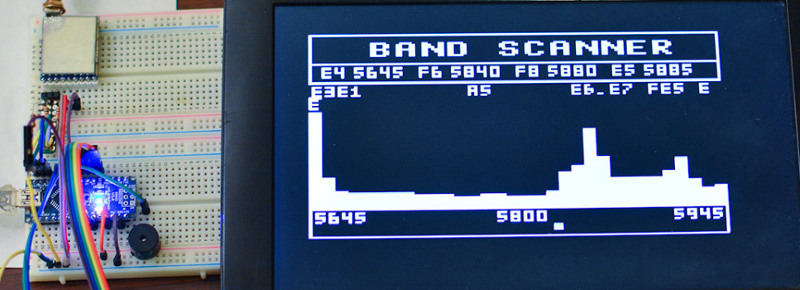First-person-view (FPV) flying, by adding a camera, video transmitter, and video goggles to the meat on the ground, is one of the best ways to experience remote-controlled flight. For just a few hundred dollars, it’s the closest thing you’re going to get to growing wings and flying through the trees of your local park. One of the most popular and cheapest ways to go about this is the Boscam RX5808 wireless receiver – a $9 module able to pull down video from an aircraft over 5.8GHz radio. Stock, this radio module is just okay, but with a few modifications, it can be turned into a very good receiver with a spectrum analyzer and autoscan.
The Boscam RX5808 has three DIP switches to allow for eight different channels for receiving video, and this is where most RC hobbyists stop. But the module also has a very capable SPI interface, and by adding a simple Arduino, the complete capabilities of this receiver can be unlocked.
The core software for the build is [markohoepken]’s rx5808-pro and rx5808_pro_osd, and [crazyheea]’s rx5808-pro-diversity to enable all the capabilities available in the RX5808 receiver. With an off-the-shelf LCD, this mess of wires and boards turns into an auto-scanning spectrum analyzer that’s also able to put video from a drone onto a screen.
[garagedrone] put together a very complete demo video of the entire build. You can check that out below.
















Amazing to see what Marco and crazyheea did out of an idea i had some time ago.
Heres the Video of my first prototype ;_)
https://www.youtube.com/watch?feature=player_detailpage&v=sQRryOsAFMg#t=43
Oh NIIIIIICE!
The filters are a bit too wideband for proper spectrum analysis (~22MHz). Still, you get to see if a channel is free or not which is all you need in the field.
A growing consern
Missreading the title made me think how great it would be to troubleshoot noise sources like powerline insulators etc. with a drone. SA onboard with video overlay, or just transmit the sample band back to base to compare to noise received at base. Some of this hash goes up to the low UHF!
I don’t see any danger in squirting water on the suspect insulator from the air. That’s a way of finding RIV effects in the whole pole and arms. Radio Influence Voltage is when loose metal things make poor contact with ground and become energized by the powerline nearby.
Am i the only one bothered by the “5880 GHz” ?
It needs a decimal point or it needs the correct unit, MHz.
I don’t think that human eye can see this subtle color difference anyway ;)
Maybe he wants to build a rape-scanner like the TSA.
The article linked to some really old videos. Decimal has been added since in the rx5808-pro-diversity version. :)
Maybe this could be useful by some Hams as a really cheap ATV receiver. I don’t know how many areas have ATV activity in the 5Ghz band but Wikipedia seems to think that it happens in a few places.
First off Thanks for featuring part of my diversity project!
There are far more to these projects then just the 5.8GHz receiver. I have also created a video transmitter that binds with the receiver via IR serial protocol. This IR feature drastically reduces the time it takes to change channels on the field during race day and removes the confusion of selecting the correct channel via dip switches.
Demo: https://www.youtube.com/watch?v=ge-of5_kmcc
GitHub: https://github.com/sheaivey/tx5823-pro
There is also an OLED version which I have designed to fit into Fat Shark modules.
https://www.youtube.com/watch?v=I4wZWitvHXw
My entire version build log has been captured over at:
http://www.rcgroups.com/forums/showthread.php?t=2477752&page=1
Thanks,
Shea Ivey / @ShIvey03 / crazyshea
http://www.laforgefpv.com